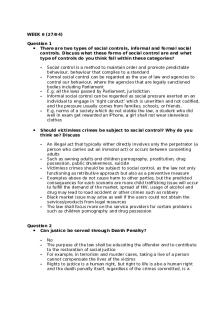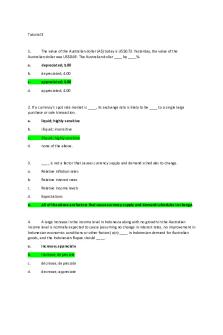Tute3-1 - Tutorial 3 PDF

| Title | Tute3-1 - Tutorial 3 |
|---|---|
| Course | Applied Microeconometric Modelling |
| Institution | University of Melbourne |
| Pages | 2 |
| File Size | 32 KB |
| File Type | |
| Total Views | 121 |
Summary
Tutorial 3...
Description
ECOM30003/ECOM90003: Applied Microeconometric Modelling Tutorial 3 This tutorial is based on ”Minimum wages and employment: A case study of the fast food industry in New Jersey and Pennsylvania” by David Card and Alan Krueger, published in the American Economic Review in 1994. Card and Krueger study the impact of an increase in the minimum wage in New Jersey, USA on employment. To do so, the authors surveyed 410 fast food restaurants in New Jersey and eastern Pennsylvania (more than one month) before the minimum wage was raised in New Jersey, and then again (about 8 months) after the minimum wage was increased in New Jersey. The increase in New Jersey’s minimum wage was legislated two years prior to its implementation, when the economy was relatively healthy. However, at the time the rise came into effect, the economy was in recession. The fast food restaurants chain included in the survey are: Burger King, KFC, Roy Rogers and Wendy’s. Note that your are not required to read this paper in order to answer the tutorial questions. You will not be able to replicate all results in the paper as I have provided you a specific data set for the assignment rather than the full raw data set, and have done a lot of cleaning for you. Please provide brief and to the point answers to the following questions. 1. Why is the fast food industry well suited to studying the impact of increasing the minimum wage on employment? Provide at least 2 reasons. 2. How can the natural experiment framework be used to estimate the causal impact of the increase in New Jersey’s minimum wage? 3. What is the role of (information from fast food restaurants in) Pennsylvania in the natural experiment set-up? Why is it important in the context of measuring the employment impacts of New Jersey’s minimum wage increase? 4. Write down an econometrics model that could be used to obtain the difference in difference (DD) estimator of the average treatment effect of New Jersey’s increase in minimum wage. For now, assume that you do not have any“additional” control variables. Be sure to explain each term and indicate which coefficient is the ATE to be estimated by the DD estimator. 5. Using the data provided, demonstrate that New Jersey’s increase in minimum wage is evident in the Card and Krueger sample. Use the sample of firms that are open in both periods and for which wage data are available in both periods. Hint: this 1
is most easily done using a linear regression. Make sure you use robust standard errors. 6. Estimate this DD model that you wrote down using the data provided. In doing so, ensure that you include in your estimation sample firms that were open in the first period but closed in the second period in addition to firms that are open in both waves of the survey and for which wage data are observed in each period. On the basis of the results, what do you conclude about the impact of the increase in the minimum wage on employment? 7. Re-estimate the DD model including controls for the chain the restaurant belong to and for ownership type (co-owned). Does this change your conclusion about the impact of the increase in the minimum wage on employment? 8. What is the key assumption that allows the DD estimator to identify the Average Treatment Effect of an increase in the minimum wage in the model you estimate? What might lead to a failure of this assumption in the context of the time the study was undertaken? 9. Are you able to test or investigate this identifying assumption? What additional information would allow you to do so?
2...
Similar Free PDFs

Tutorial 3
- 3 Pages

Tutorial 3
- 4 Pages

Tutorial 3
- 4 Pages

Tutorial 3
- 12 Pages

3 - tutorial
- 6 Pages

Tutorial 3
- 6 Pages

Tutorial 3
- 4 Pages

Tutorial 3 - Lecture notes 3
- 5 Pages

Tutorial 3 Answers
- 4 Pages

Tutorial 3 Solutions - EC202
- 4 Pages

Tutorial 3 Solution - investment
- 3 Pages

Tutorial 3 - ccc
- 1 Pages

Tutorial work - 1 - 3
- 31 Pages

Tutorial 3 - Answers
- 6 Pages

OD tutorial 3
- 5 Pages

DEL tutorial 3
- 2 Pages
Popular Institutions
- Tinajero National High School - Annex
- Politeknik Caltex Riau
- Yokohama City University
- SGT University
- University of Al-Qadisiyah
- Divine Word College of Vigan
- Techniek College Rotterdam
- Universidade de Santiago
- Universiti Teknologi MARA Cawangan Johor Kampus Pasir Gudang
- Poltekkes Kemenkes Yogyakarta
- Baguio City National High School
- Colegio san marcos
- preparatoria uno
- Centro de Bachillerato Tecnológico Industrial y de Servicios No. 107
- Dalian Maritime University
- Quang Trung Secondary School
- Colegio Tecnológico en Informática
- Corporación Regional de Educación Superior
- Grupo CEDVA
- Dar Al Uloom University
- Centro de Estudios Preuniversitarios de la Universidad Nacional de Ingeniería
- 上智大学
- Aakash International School, Nuna Majara
- San Felipe Neri Catholic School
- Kang Chiao International School - New Taipei City
- Misamis Occidental National High School
- Institución Educativa Escuela Normal Juan Ladrilleros
- Kolehiyo ng Pantukan
- Batanes State College
- Instituto Continental
- Sekolah Menengah Kejuruan Kesehatan Kaltara (Tarakan)
- Colegio de La Inmaculada Concepcion - Cebu